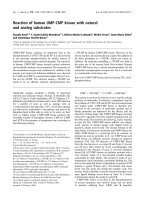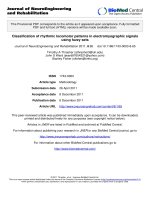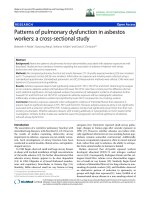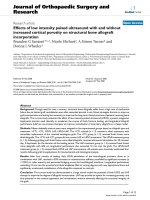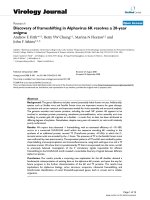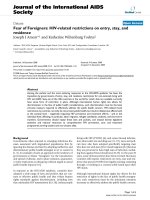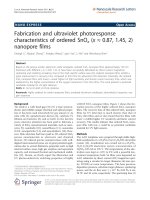báo cáo hóa học: " Fabrication of flexible UV nanoimprint mold with fluorinated polymer-coated PET film" docx
Bạn đang xem bản rút gọn của tài liệu. Xem và tải ngay bản đầy đủ của tài liệu tại đây (1.77 MB, 5 trang )
NANO EXPRESS Open Access
Fabrication of flexible UV nanoimprint mold with
fluorinated polymer-coated PET film
Ju-Hyeon Shin
1
, Seong-Hwan Lee
1
, Kyeong-Jae Byeon
1
, Kang-Soo Han
1
, Heon Lee
1*
and Kentaro Tsunozaki
2
Abstract
UV curing nanoimprint lithography is one of the most promising techniques for the fabrication of micro- to nano-
sized patterns on various substrates with high throughput and a low production cost. The UV nanoimprint process
requires a transparent template with micro- to nano-sized surface protrusions, having a low surface energy and
good flexibility. Therefore, the development of low-cost, transparent, and flexible templates is essential. In this
study, a flexible polyethylene terephthalate (PET) film coated with a fluorinated polymer material was used as an
imprinting mold. Micro- and nano-sized surface protrusion patterns were formed on the fluorinated polymer layer
by the hot embossing process from a Si master template. Then, the replicated pattern of the fluorinated polymer,
coated on the flexible PET film, was used as a template for the UV nanoimprint process without any anti-stiction
coating process. In this way, the micro- to nano-sized patterns of the original master Si template were replicated
on various substrates, including a flat Si substrate and curved acryl substrate, with high fidelity using UV
nanoimprint lithography.
Introduction
In order to form micro- t o nano-sized patterns, various
lithographic technologies have been used, such as DUV
photolithography [1], e-beam lithography [2,3], X-ray
lithography [4,5], laser holographic lithography [6],
nanosphere lithography [7] , scanning probe mic roscopy
lithography [8], and so on. Except f or DUV photolitho-
graphy, these convention al lithography technologies
require either a compl icated patterning system with a
high process cost or offer limited throughput and, thus,
are not suitable for mass production. None of these
technologies allow micro- to nano-sized patterns to be
formed on a non-flat surface. Recently, nanoimprint
lithography [9-11] has emerged as one of the most effec-
tive technologies to fabricate micro- to nano-sized pat-
terns. Due to its low process co st and high throughput,
nanoimprint technology can be used for the mass pro-
duction of nano-sized patterns [12,13].
UV nanoimprint templates need to have high stiffness
in order for the nano-sized protrusion patterns to be
transferred to the substrate and sufficient flexibility for
conformal contact to be achieved over a large-sized
substrate. Flexible templates can be applied to non-pla-
nar substrates. In addition, high transparency to UV is
required for the template to be used for UV nanoim-
print lithography. A sufficientlylowsurfaceenergyis
also necessary to avoid the need for an anti-sticking
coating on the template , which would require the extra
deposition of a Si oxide layer [14,15],
In this study, a fluorinated polymer layer was coated
on a flexible polyethylene terephthalate (PET) film, since
micro- to nano-sized patterns can easily be formed on a
fluorinated polymer layer by the hot embossing process
[16,17], and fluorinated polymers have a very low sur-
face energy [18,19]. With this fluorinated polymer-
coated flexible PET mold, micro- to nano-sized patterns
were fabricated on a flat Si substrate and curved acryl
substrate with high fidelity using UV nanoimprint
lithography.
Experimental procedure
Fabrication of flexible UV nanoimprint mold
Figure 1 shows experimental schematics and detailed
process flow of hot embossing litho graphy system and
UV nanoimprint lithography system made by NND
(Seoul) in Korea. Both systems used to fabricate nano-
sized patterns are of the vessel type.
* Correspondence:
1
Department of Materials Science and Engineering, Korea University, Anam-
dong 5-ga, Seongbuk-gu, Seoul 136-713, South Korea
Full list of author information is available at the end of the article
Shin et al. Nanoscale Research Letters 2011, 6:458
/>© 2011 Shin et al; licensee Springer. This is an Open Access article distributed under the terms of the Creative Commons Attribution
License ( which permits unrestricted use, distribution, and reproduc tion in any medium,
provided the original work is properly cited.
Figure 2 shows the overall fabrication process of the
UV nanoimprint template using the hot embossing pro-
cess of a PET film coated with a fluorinated polymer
layer. An aligned stack consisting of the master Si mold
and PET film was loaded in the UV nanoimprint system,
as described elsewhere [20] and heated up to 130nu°C.
A pressure of 20 bars was applied to fill the cavity of
the Si master mold with the fluorinated polymer. After
cooling to 70°C, the Si master mold was demolded from
the patterned fluorinated polymer-coated flexible PET
mold. Finally, reversed patterns were formed on the
fluorinated polymer-coated flexible PET film.
The contact angles of the unpatterned and hot-
embossed fluorinated polymer surfaces are shown in
Figure 3. Prior to the hot embossing process used to
form the nano-sized patterns, the contact angle of the
unpatterned fluorinated polymer surface was 105°. After
the hot embossing process, the contact angle of the
fluorinated polymer-coated flexible PET mold was
increased to 110°. This result demonstrates that the sur-
face energy of the fluorinated polymer was inherently
high, so that it can be used as an imprinting mold to
fabricate micro- to nano-sized patterns without the need
to coat it with an anti-stiction layer.
Imprinting process using replicated flexible UV
nanoimprint mold
A hot-embossed flexible PET mold was used as a tem-
plate for UV nanoimprint lithography without the
coating of an anti-stiction layer. As shown in Figure
4a,b, the UV nanoimprint process was performed on
both a flat Si wafer and curved acryl substrate. The
same imprinting system as that employed for the hot
embossing process of the fluorinated polymer-coated
flexible PET mold was used. A monomer-based UV
curable resin, NIP-K28™ , made by the ChemOptics
Company (Daejeon, South Korea) was used. As shown
in a previous report [21], an isotropic pressure was
applied through a flexible membrane to assure uniform
pressing between the PET film mold and substrate.
Due to the flexibility of the PET mold, conformal con-
tact can be achieved between the PET mold and
curved substrate, and a uniform pressing force can be
delivered. A pressure of 20 bars and UV light with a
wavelength of 365 nm were used in the imprinting
process.
Results and discussion
Photographic images
Figure 5a,b,c,d shows the photographic images of the Si
master mold, hot-embossed fluorinated polymer-coated
flexible PET fil m and imprinte d resist p atterns on the flat Si
substrate and curved acryl subst rate made using the hot-
embossed PET film, respectively. Both the hot embossing
and UV nanoimprint patterning processes were done on
largesizesubstrateswithoutanynoticeabledefects.
SEM micrographs
Figure 6 shows the scanning electron microscopy (SEM)
micrographs of the micro- and nano-sized patterns on
the master Si mold and replicated patterns on the
Figure 1 Schematic drawing. Schematic drawing of (a) hot
embossing lithography system and (b) UV nanoimprint lithography
system.
Figure 2 Fabrication of UV nanoimprint template.Fabrication
using hot embossing process of PET film coated with fluorinated
polymer layer.
Shin et al. Nanoscale Research Letters 2011, 6:458
/>Page 2 of 5
fluorinated polymer-coated flexible PET film by hot
embossing lithography. An S-4300 SEM system from
Hitachi was used. As shown in Figure 6, the micro- and
nano-sized patterns on the master Si mold were repli-
cated onto the fluorinated polymer-coated flexible PET
film by hot embossing lithography with high fidelity and
without any defects . Due to the slightly tapered profile
of the patterns of the Si master mold and elastic nature
of the hot embossing process of the fluorinated polymer,
the hot -embossed patterns on the PET films were
slightly smaller than the patterns of the Si master mold.
The SEM micrographs of the imprinted micro- and
nano-sized patterns made by UV nanoimprint lithogra-
phy using the hot-embo ssed fluorinated polymer-coated
PET film are shown in Figure 7. The hot-embossed flex-
ible PET film, coated with the fluorinated polymer, was
used as the UV imprint mold. Figure 7a,b,c show the
imprinted resist patterns on the flat Si substrate using
UV nanoimprint l ithography. The shape and size of the
micro-sized, complex patterns of the Si master mold
were replicated with high fidelity on the flat Si substrate.
Even sub-200-nm-sized nanopatterns were able to be
finely replicated. Figure 7d,e,f shows the imprinted resist
patterns on the curved acryl substrate. Due to the uni-
form pressing of the flexible PET film mold over the
curved substrate, micro- and nano-sized patterns were
able to be successfully imprinted on a curv ed acryl sub-
strate. These results imply that a hot-embossed flexible
PET film, coated with a fluorinated polymer layer, can
be used as a mold for the UV nanoimprint lithography
of various substrates, including non-planar ones.
Furthermore, 20- to approximately 30-nm-sized line/
space patterns were fabricated on the f lat Si substrate
and on the curved acryl substrate. As shown in Figure 8,
these patterns were fabricated very finely.
Conclusions
The micro- a nd nano-sized surface protrusion patterns
of the master template were transferred with high fide-
lity to the flexible PET film, coated with the fluorinated
polymer material, by the hot embossing process.
Since the surface energy of fluorinated polymers is as
high as 105° for DI water, a flexible PET film with a pat-
terned fluorinated polymer can be used as a stamp for
the UV nanoimprint process without the need for an
anti-stiction coating.
Figure 3 Change of contact ang le by fabricated pattern using hot embossing lithography. (a) Before fabricat ing patterns and (b) after
fabricating patterns.
Figure 4 Imprinting process using replicated fluorinated
polymer-coated flexible PET mold. (a) Imprinted on flat Si
substrates and (b) imprinted on curved acryl substrates.
Shin et al. Nanoscale Research Letters 2011, 6:458
/>Page 3 of 5
Due to the uniform pressing of the f lexible PET film
mold over either the flat Si wafer or curved acryl sub-
strate, the micro- and nano-sized patterns of the
embossed PET film were successfully imprinted onto
the substrates using the UV nanoimprint process.
Figure 5 Photographic images. (a) Si master mold, (b) hot-embossed fluorinated polymer-coated flexible PET film, (c) imprinted resist patterns
on flat Si substrates using hot-embossed PET film shown in b, and (d) imprinted resist patterns on curved acryl substrates using hot-embossed
PET film shown in (b).
Figure 6 SEM micrographs. (a, b, c) micro- and nano-sized
patterns on master Si mold, (d, e, f) replicated micro- and nano-
sized patterns on fluorinated polymer-coated flexible PET film by
hot embossing lithography.
Figure 7 SEM micrographs of imprinted resist patterns by UV
nanoimprint lithography. Using hot-embossed fluorinated
polymer-coated PET film, (a, b, c) imprinted resist patterns on a flat
Si substrate and (d, e, f) imprinted resist patterns on a curved acryl
substrate.
Shin et al. Nanoscale Research Letters 2011, 6:458
/>Page 4 of 5
Acknowledgements
1This work was supported by the Nano Research and Development
program through the Korea Science and Engineering Foundation funded by
the Ministry of Education, Science and Technology (2010-0019152) and Basic
Science Research Program through the National Research Foundation of
Korea (NRF) funded by the Ministry of Education, Science and Technology
(NRF-2011- 0004819).
Author details
1
Department of Materials Science and Engineering, Korea University, Anam-
dong 5-ga, Seongbuk-gu, Seoul 136-713, South Korea
2
Asahi Glass Co., Ltd.,
Research Center, 1150 Hazawa-cho, Kanagawa-ku, Yokohama-shi, Kanagawa
221-8755, Japan
Authors’ contributions
JHS carried out overall experiments including nanoimprint lithography works
as the first author.
SHL was in charge of hot embossing experiment using Si master mold.
KJB carried out the fabrication of Si mold.
KSH was in charge of self-assembled monolayer coating of Si mold
HL conducted design and analysis of all experiments as a corresponding
author.
KT made fluoro-resin coated PET film which was used as a substrate for hot
embossing process.
Competing interests
The authors declare that they have no competing interests.
Received: 14 April 2011 Accepted: 18 July 2011 Published: 18 July 2011
References
1. Mimura Y, Ohkubo T, Takeuchi T, Sekikawa K: Deep-UV photolithography.
Jpn J Appl Phys 1978, 17:541-550.
2. Kise K, Watanabe H, Itoga K, Sumitani H, Amemiya M: Improvement of
resolution in X-ray lithography by reducing secondary electron blur. J
Vac Sci & Technol B 2004, 22:126-130.
3. Liu K, Avouris P, Bucchignano J, Martel R, Sun S: Simple fabrication
scheme for sub-10 nm electrode gaps using electron-beam lithography.
Appl Phys Lett 2002, 80:865-867.
4. Murray A, Scheinfen M, Isaacson M, Adesida I: Radiolysis and resolution
Limits of inorganic halide resists. J Vac Sci & Technol B 1985, 3:367-372.
5. Feiertag G, Ehrfeld W, Freimuth H, Kolle H, Lehr H, Schmidt M, Sigalas MM,
Soukoulis CM, Kiriakidis G, Pedersen T, Kuhl J, Koenig W: Fabrication of
photonic crystals by deep X-ray lithography. Appl Phys Lett 1997,
71:1441-1443.
6. Campbell M, Sharp DN, Harrison MT, Denning RG, Turberfield AJ:
Fabrication of photonic crystals for the visible spectrum by holographic
lithography. Nature 2000, 404:53-56.
7. Su YK, Chen JJ, Lin CL, Chen SM, Li WL, Kao CC: GaN-based light-emitting
diodes grown on photonic crystal-patterned sapphire substrates by
nanosphere lithography. Jpn J Appl Phys 2008, 47:6706-6708.
8. Ogino T, Nishimura S, Shirakashi J: Scratch nanolithography on Si surface
using scanning probe microscopy: influence of scanning parameters on
groove size. Jpn J Appl Phys 2008, 47:712-714.
9. Chou SY, Krauss PR, Renstrom PJ: Imprint of sub-25 nm vias and trenches
in polymers. Appl Phys Lett 1995, 67:3114-3116.
10. Chou SY, Krauss PR, Zhang W, Guo L, Zhang L: Imprint lithography with
25-nanometer resolution. J Vac Sci Technol B 1997, 15:2897-2904.
11. Lee H, Jung KY: UV curing nanoimprint lithography for uniform layers
and minimized residual layers. Jpn J Appl Phys 2004, 43:8369-8373.
12. Colburn M, Johnson S, Stewart M, Damle S, Vailey T, Choi B, Wedlake M,
Michaelson T, Sreenivasan SV, Ekerdt J, Willson CG: Step and flash imprint
lithography: a new approach to high-resolution patterning. Proc SPIE
1999, 3676:379.
13. Chou SY, Krauss PR, Renstrom PJ: Imprint lithography with 25-nanometer
resolution. Science 1996, 272:85-87.
14. Kawaguchi Y, Nonaka F, Sanada Y: Fluorinated materials for UV
nanoimprint lithography. Microelectron Eng 2007, 84:973-976.
15. Tsunozaki K, Kawaguchi Y:
Preparation methods and characteristics of
fluorinated polymers for mold replication. Microelectron Eng 2009,
86:694-696.
16. Becker H, Heim U: Hot embossing as a method for the fabrication of
polymer high aspect ratio structures. Sensor Actuat A-Phys 2000,
83:130-135.
17. Heckele M, Bacher W, Muller KD: Hot embossing - the molding technique
for plastic microstructures. Microsyst Technol 1998, 4:122-124.
18. Hirai Y, Yoshida S, Okamoto A, Tanaka Y, Endo M, Irie S, Nakagawa H,
Sasago M: Mold surface treatment for imprint lithography. J Photopolym
Sci Technol 2001, 14:457-462.
19. Bailey T, Choi BJ, Colbum M, Meissl M, Shaya S, Ekerdt JG, Sreenivasan SV,
Willson CG: Step and flash imprint lithography: Template surface
treatment and defect analysis. J Vac Sci Technol B 2000, 18:3572-3577.
20. Hong SH, Han KS, Byeon KJ, Lee H, Choi KW: Fabrication of sub-100 nm
sized patterns on curved acryl substrate using a flexible stamp. Jpn J
Appl Phys 2008, 47:3699-3701.
21. Hong SH, Bae BJ, Han KS, Hong EJ, Lee H, Choi KW: Imprinted moth-eye
antireflection patterns on glass substrate. Electron Mater Lett 2009,
5:39-42.
doi:10.1186/1556-276X-6-458
Cite this article as: Shin et al.: Fabrication of flexible UV nanoimprint
mold with fluorinated polymer-coated PET film. Nanoscale Research
Letters 2011 6:458.
Submit your manuscript to a
journal and benefi t from:
7 Convenient online submission
7 Rigorous peer review
7 Immediate publication on acceptance
7 Open access: articles freely available online
7 High visibility within the fi eld
7 Retaining the copyright to your article
Submit your next manuscript at 7 springeropen.com
Figure 8 SEM micrographs of imprinted 20- to approximate ly
30-nm-sized patterns by UV nanoimprint lithography. Using
hot-embossed fluorinated polymer-coated PET film (a) imprinted
patterns on a flat Si substrate and (b) imprinted patterns on a
curved acryl substrate.
Shin et al. Nanoscale Research Letters 2011, 6:458
/>Page 5 of 5
